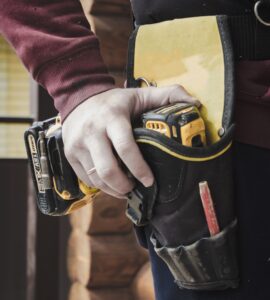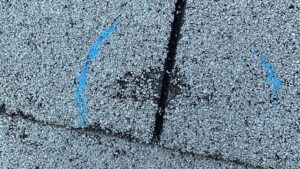A full roof replacement is a large and significant home renovation project. As a homeowner, it’s important for you to understand some basic facts about what you’re going to take on.
But don’t worry.
A roof replacement is a straightforward construction project with well-established costs, timelines, and expectations. And roofing warranties are available from both major product manufacturers and licensed, professional roofing contractors.
All you need to do is get a clear idea of what this work entails. After that, things should progress smoothly once you find a qualified roofing company and get things started.
This overview of basic roofing replacement insights will get you up to speed.
How Do I Know if My House Needs a Roof Replacement?
A roof should be replaced when it’s reached the end of its lifespan, has severe performance issues, or has been severely damaged.
Roofs have different lifespans depending on what material was used – and the quality of installation. Asphalt shingle roofs are expected to last 15 to 30 years. Slate lasts 50 to 100 years or more.
A roof that’s reached the end of its lifespan might seem to be working well, but the warranty will be up and there’s a good chance its performance has already diminished.
Some visible signs of an aged and compromised roof include shingle bald spots, curling or lifted shingles, cracks and broken pieces, green plant growth, and sagging.
One thing to consider is that a roof doesn’t have to leak to be underperforming or compromised. The house may simply have excess moisture and condensation issues or show signs of subpar energy efficiency.
On the other hand, there are times when severe roofing damage can be fixed with a partial replacement and repair.
It isn’t always easy to tell if a roof needs a full replacement or can be repaired. So it’s always best to get a proper roofing inspection done.
Roofing companies like Canopy provide homeowners with free, no-obligation roof inspections. And as licensed and insured roofers, our inspection results are accepted by homeowners insurance companies. Reach out to us if you haven’t had one done yet or want a second opinion.
Please remember that homeowners insurance doesn’t cover damages that occur due to housing neglect. Failing to have a roof that’s in good condition or within its intended lifespan may result in being denied coverage. A good inspection will give you a clear overview of the situation.
What Roof Replacement Materials Are Available?
Residential roof materials include asphalt shingles, slate tiling, cedar shingles and shakes, galvanized steel, and concrete.
Asphalt is one of the most common and versatile roofing materials. It’s affordable, widely manufactured, and comes in several different colors, textures, and looks.
Slate stone is a long-lasting roofing material and is best for homeowners interested in a product that will withstand the test of time.
Cedarwood is a weather and pest-resistant roofing material. It’s available in shingles and shakes, which are beautiful but expensive and not the most fire-resistant.
Galvanized steel is a zinc-coated steel roofing product that’s available in panels or in shingle style. This might seem only fit for industrial purposes, but it gives residential houses a tasteful contemporary look. Galvanized steel is durable without being as expensive as stainless steel.
Concrete is another industrial roofing product that’s crept into residential use. Much like steel roofing, concrete products are available as long panels or styled like shingles or tiles. Concrete is fairly durable but on the heavier side.
How Much Does a Roof Replacement Cost?
The total cost of replacing a roof depends on the roof’s square footage, design, and materials.
The average roof is between 1,000 to 3,000 square feet. It can cost around $11,500 to replace a standard roof of this size. Smaller roofs can be replaced for as little as $6,700 while larger, more ornate roofs may cost as much as $80,000.
A roof’s pitch or slope makes it more complicated to work on. Flat roofs cost less while higher pitched roofs cost more.
Roofing materials also add to the cost. Some products are more complicated to install – and therefore more expensive.
Check this general reference list for product plus installation costs:
- Asphalt shingles: $8,000 to $17,000
- Slate tiles: $19,000 to $52,000
- Cedar shakes: $14,000 to $32,000
- Galvanized steel: $14,000 to $30,000
- Concrete tile: $15,000 to $40,000
How Long Does a Roof Replacement Take?
A new roof can be put in within a day or two. Roofing replacements take a little longer since the old roof will need to be removed and cleaned up first.
An average-sized asphalt shingle roof (around 3,000 sq. ft.) can be replaced within 1 to 3 days. A wood shingle or shake roof replacement can take 6 to 8 days. A slate tile roof can take 6 to 7 days to replace.
Weather issues or structural complications can extend these timeframes by a few days to a week or more.
Is a Full Roof Replacement Needed to Repair Storm Damage?
Maybe, but not necessarily.
Even extensive storm damage can be fixed with a partial renovation. However, sometimes there are issues requiring a full roof replacement.
There’s no way to tell if a full replacement is called for without having a roofer inspect it first.
Does Insurance Pay for a Roof Replacement?
Homeowners insurance will pay for roofing damage that was caused by an accidental event, act of nature, or other covered cause. A typical covered event is a severe storm with heavy winds.
It typically won’t pay for a roof that needs to be replaced due to age, wear and tear, natural weathering, or poor upkeep. That’s unfortunate since neglecting to properly maintain a roof can also invalidate the product and installation warranty.
So, make sure to have yours regularly inspected, cleaned, and maintained throughout its lifetime. That will keep any repair costs down and ensure the roof lasts as long as it’s supposed to.
When it’s finally time for a full roof replacement, have a qualified, licensed, and insured roofing company take on the job.
Ask Us About Roofing Replacements and Structural Repairs
Midwest Roof & Solar is an experienced, full-service Minneapolis roofing company. Our roofing professionals handle everything from basic shingling and spot treatments to new roofing builds, full roof replacements, and structural repairs.





